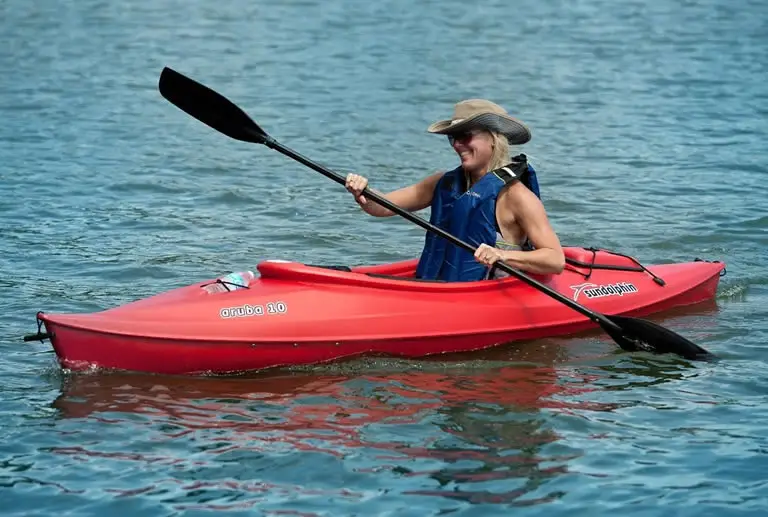Contents
- How To Find The Best Sit In Kayak
- How To Find The Best Sit In Kayak For Your Needs
- The 6 Different Types Of Kayaks & How They Are Used
- 1. Recreational Kayaks Are Prefect For Calm Weather Paddling & For Beginners
- 2. Whitewater Kayaks Are Ideal For Turbulent River Use
- 3. Surf Kayaks Let You Ride The Waves
- 4. Sea/Touring Kayaks
- 5. Fishing Sit In Kayaks
- 6. Racing Kayaks Are Used For Amateur And Professional Racing
- The take-away – how to find the best sit in kayak for you
How To Find The Best Sit In Kayak
What makes the job even harder is the fact that each kayak type (there are 6) is engineered to do a particular job.
Where it is safe and advisable to use one type of kayak, that same kayak may be dangerous to use in a different setting and marine environment.
So, it’s important to know which type of kayak you need before you look to purchasing one.
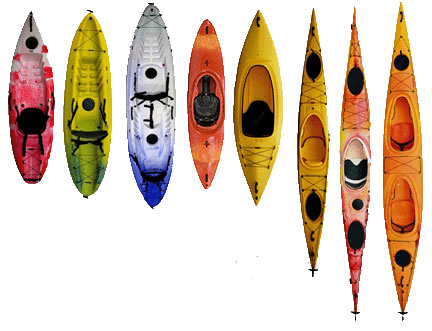
No matter if it’s surfing the rapids, leisurely cruising a calm river, or fighting the waves, it’s the design of the kayak that makes it the best one for the job not necessarily the make or model.
That is why I describe below the 6 different types of kayak and what they are designed to be used for. I also give you examples of the best kayak models in each category.
Not all kayaks are the same
Not all kayaks are made alike.
To find the best sit in kayak for your needs you must first determine what you intend to use the watercraft for.
Different kayak hull designs are used for different applications and environments.
For example, a flat bottom kayak is great for calm river use but is a bad choice for ocean or whitewater use.
Finding the best kayak starts with finding the right type of kayak.
Regardless of whether you are a beginner or have some experience on the water, or even if you are just stuck making a decision between a hard shell or inflatable, this article aims to help.
After reading you will be better informed to make the correct decision to get the best kayak for you and your specific needs.
How To Find The Best Sit In Kayak For Your Needs
The vast range of kayak choices available today can easily have you, not only spoiled for choice but also, confused and frustrated about which choice to make.
The first thing you need to do is ask yourself the following questions:
What will I use my sit in kayak for?
Where will I use the sit in kayak?
Answering these questions will help you pick the best type of kayak for your needs.
Once you know which type of kayak you need it is simply a matter of looking at reviews (from proven users) of the top kayaks in that category.
There are different types of kayak, each designed for a specific purpose.
Below are the different types of kayaks that have been designed for different applications and environments along with a few suggestions on the best kayaks in that category.
But before we look at the different kayak designs available it is a good idea to acquaint yourself with some basic kayaking design principles.
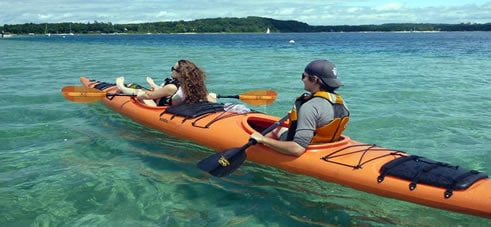
Different kayaks have different designs which can affect stability & your buying choice
Before we look at the specific types of kayaks available and their ideal applications I first need to introduce you to the concept of primary and secondary stability.
A word about primary and secondary stability
The design of a kayak, and a canoe, is based on the two stability features called primary stability and secondary stability.
In basic terms, primary stability refers to a vessel’s ability to stay stable while sitting still on calm water.
Secondary stability refers to a vessels ability to stay stable when it is tipped on its side or rocked by choppy water.
The above is a basic explanation but should give you enough of an understanding of this concept to see how stability concerns affect the design of a kayak.
If you need a more in-depth explanation of primary and secondary stability and how it affects the design of a kayak read this article.
There is always a trade-off between primary and secondary stability.
You see, if you have a kayak with exceptional primary stability then it will have poor secondary stability.
This means that this type of kayak will be great for use on calm water and will be very easy for beginners to use because it will be very stable and hard to tip over.
However, when the same kayak is used in choppy water, like the ocean or on open waters on a windy day, it will be unstable as it is rocked on the waves.
A quick explanation of “chine”
Just as primary and secondary stability are important factors on a kayak so too are the chine and the rocker.
What do these terms mean?
Chine simply refers to the curve, or lack of it, at the bottom of the boat. The chine is the amount of curve that takes place between the sides of the boat and its bottom.
For example, a flat bottom kayak has a soft chine while a v-shaped bottom kayak has a hard chine.
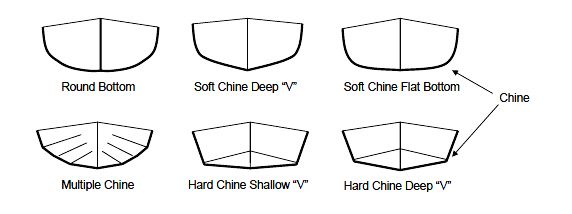
If you need a better understanding of chine you can read a more detailed description of how it as it relates to a kayak here.
Where “rocker” comes in
The rocker of a kayak refers to roundness of the entire boat.
This greatly affects the stability of the kayak in challenging conditions where the boat will be hit by waves – such as in rough sea conditions or bad weather.
The rocker is a component, along with curved sides, that contributes to a kayak’s secondary stability.
A kayak used in calm inland waters does not need much rocker as it is much more advantageous to have better primary stability on flat calm water.
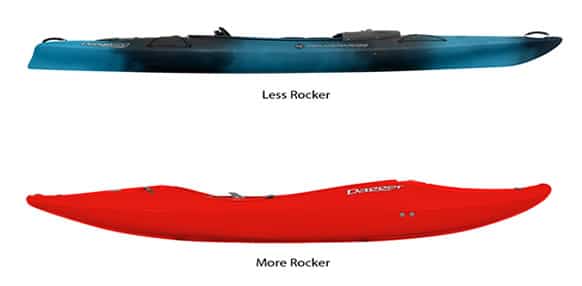
A rule-of-thumb to follow is:
A kayak used on calm water needs better primary stability.
A kayak used on choppy water needs better secondary stability.
So if you plan to use your kayak on calm inland waters you will need a kayak with good primary stability.
But, if you want to venture into the ocean or ride whitewater rapids then you will need a kayak with good secondary stability.
Of course there are kayaks that are designed to incorporate some aspects of primary stability and some aspects of secondary stability.
A fishing kayak will usually fall into this category.
A fishing kayak needs to have good secondary stability to handle rough water but that also needs good primary stability for fishing in one spot.
Rather than leaving you feeling bewildered about how you go about finding these types of kayaks below are explanations of the ideal vessels based on the type of activity you plan to engage in.
The 6 Different Types Of Kayaks & How They Are Used
Below I cover the 6 basic kayak types and what they are used for.
It is important to know the difference between these kayaks as your choice of boat will depend on your purpose for it.
Once you know which boat is a better fit for the water based activity you want to use it for, you will be able to purchase the correct type of kayak.
This is important as mist kayak accidents occur because people use the wrong type of kayak for the activity they are engaged in.
The 6 kayak types
Below are the 6 different types of kayak commonly seen on the water.
- Recreational kayak.
- Whitewater kayak.
- Surf kayak.
- Touring or sea kayak.
- Fishing kayak.
- Racing kayak.
Let’s take a closer look at each of these kayak types now.
1. Recreational Kayaks Are Prefect For Calm Weather Paddling & For Beginners
Recreational kayaks are, arguably, the most common type of kayak seen on the water.
When it comes to a day-trip or short weekend escape on calm scenic inland waters, a recreational kayak can do the job like no other.
Recreational kayaks are probably the most common types of kayaks you will see unless you are heavily involved in water sports, hunting or fishing because they are ideal for beginners.
Recreational kayaks have a flat bottom and offer the most stability on calm waters.
This is why they are the most common type of kayak used for day trips and tourist trips.
The best recreational kayak will be designed for stability
These types of kayaks are usually designed with polyethylene composite, or other hard lightweight materials. because they tend to get knocked around quite a lot.
The hull tends to be rounded with a sharp chine, though some beginner boats will have a softer chine for easier handling.
They usually have very little rocker because they don’t need it; most recreational kayaks are used on very calm waters in fair weather conditions.
Most recreational kayaks have a flat bottom and sides that are straight or only slightly curved.
This design offers the best primary stability making them great for beginners and for day cruises on calm inland waters.
Some people wrongly think that because recreational kayaks are ideal for beginners they are novice boats.
Just because they are good for beginners does not mean they are beginner kayaks!
An experienced kayaker will be just as likely to use a recreational kayak on calm waters as a beginner.
These vessels are ideal to spend a leisurely day on a calm lake or easy flowing river or stream when you are carrying minimum gear.
They come designed with enhanced stability for calm water and offer easy maneuverability.
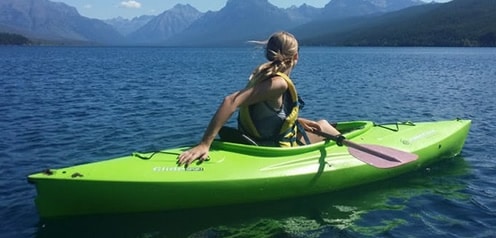
You can get recreational kayaks for single-person use or ones that can carry up to 4 people.
For more reasons why you should choose this type of kayak read the article why choose a flat bottom kayak.
Some recreational kayaks offer a good deal of storage space especially the larger craft designed for two or more people.
However, even in a single-person recreational kayak you should be able to get at least a backpack into the cockpit with you.
If you need more space, say for camping, then you may be better with a touring kayak, also known as a sea kayak (see our guide to kayaking in the ocean).
Pros of recreational kayaks
- User-friendly and the best recreational kayak for beginners or novice paddlers.
- The flat bottom and straight sides makes recreational kayaks great for calm inland waters such as rivers, streams, lakes etc.
- Large cockpits give plenty of room.
- They offer exceptional stability on calm water.
- They are great for tracking on meandering rivers and lakes.
Cons of recreational kayaks
- Kayaks of these types, with a flat bottom, are not good for choppy water.
- Although they are designed for recreational use they are not good for whitewater, rapids, ocean use etc.
- Storage is limited to stash spots.
- Don’t overload them or you will compromise their stability – more gear means less stability.
- These kayaks are not suitable for use in challenging weather.
Top choices – the 2 best recreational kayaks
Below are some of the most popular recreational kayaks, that are affordable, very stable, easy to get in and out of, and simple to turn and paddle.
I have included a mix of different types based on construction material and size.
For example the 2-person kayak I list is an inflatable but there are 2-person Polythene models available in the marketplace.
So, be sure to shop around.
Sun Dolphin 10ft – best recreational kayak for the beginner
This hard shell boat is an affordable single-person Polyethylene recreational kayak.
It offers a large cockpit with an adjustable padded seat and a covered storage compartment.
There is ample room in the cockpit for a backpack.
Nice little touches like a bottle holder and carrying handles help to make this recreational kayak great value for money.
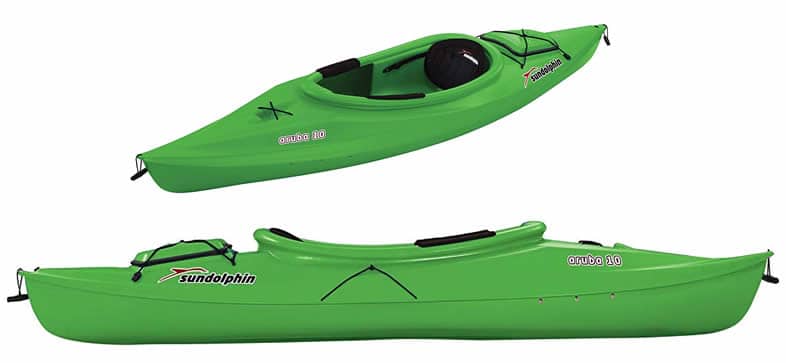
It is also available in a range of colors and at only 40lbs it is lightweight enough to hoist onto the roof of a vehicle single handed and for portage.
The Lagoon 2 – the best recreational kayak for couples
The Lagoon 2 is a great 2 person inflatable recreational kayak that comes with built in ridges at the bow and stern for improved tracking.
The fast inflating “Twistlok” with high-flow spring valves makes for a very easy and fast setup and because it is inflatable and at only 37 lbs this kayak is very easy to transport and carry.
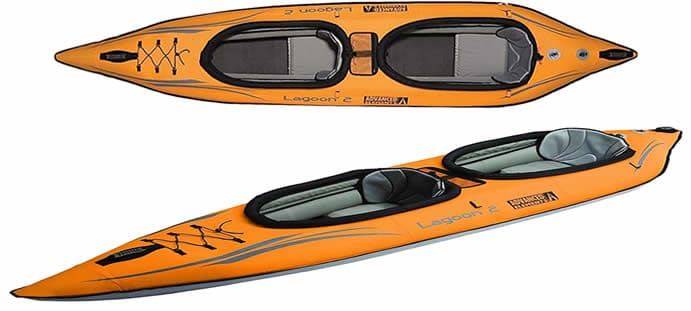
At 12 ft with a 350 lb weight capacity this kayak is incredible value for money.
2. Whitewater Kayaks Are Ideal For Turbulent River Use
Planning to get drenched as you dabble in the most adventurous, thrilling and “dangerous” of all kayaking experiences?
Whitewater kayaking requires a special type of kayak designed to be able to ride rapids and turbulent water while staying afloat.
Whitewater kayaks are also called river kayaks.
The type of whitewater kayak used will sometimes depend on the turbulence of the water, the skill level of the paddler, along with their tenacity and acceptance for danger.
However, most whitewater kayaks follow the same design with some focus placed on primary stability and a lot of focus placed on secondary stability and sturdiness.
Each whitewater kayak is made to be versatile enough to handle calm water one minute and turbulent water the next. They are extremely sturdy vessels made to meet the demands of whitewater environments where the boat is likely to bounce off obstacles.
The design of the whitewater kayak helps prevent it from tipping in turbulent water
Whitewater kayaks have a very distinctive design that sets them apart from other kayak types. Their turned-up nose and and flat stern give them a very distinctive personality.
It’s the carefully designed hull along with the traditional sit in position and round rocker that makes a whitewater kayak the best kayak for very turbulent, obstacle-ridden waters.
Generally made of high-quality hard, but lightweight, materials these fast-moving hard-shell kayaks come with very little storage space – you are limited to what you can fit in the cockpit with you.
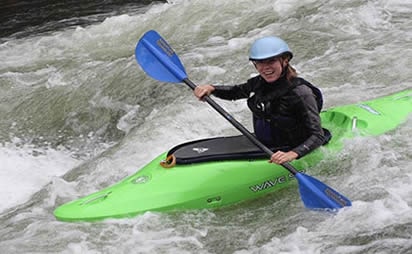
They are a tight fit with secure decking to keep the water out.
Even though whitewater kayaks feel extremely tippy in calm water, their design makes them very difficult to tip.
Pros of a whitewater kayak
- Whitewater kayaks are very resilient and can take some hard knocks.
- These boats have a lot of rocker to avoid capsizing in turbulent water.
- Closed off decking is essential to avoid water entering the boat.
- They are easy to roll (you can quickly upright yourself should your boat turn over).
Cons of a whitewater kayak
- They are not a great choice for beginners or the claustrophobic.
- Whitewater kayaks can feel tippy in calm water, though they are actually hard to tip.
- These watercraft don’t offer an easy move in and out option if the boat is capsized – you need to know what you are doing to exit the boat quickly and safely.
The 2 best whitewater kayaks for beginners & intermediates
Below are 2 examples of good whitewater kayaks for beginner paddlers.
The LiquidLogic Braaap 69 – best whitewater kayak for beginners & the more experienced
The LiquidLogic Braaap 69 is a very versatile hard-wearing whitewater kayak.
It offers great control for the experienced kayaker though it is also a good to boat to start with if you are a novice at river running.
It comes with a full plate footrest and two security bars.
The ratchet adjustable backrest system ensures complete comfort along with seat hip pads and adjustable thigh braces for a very comfortable fit.
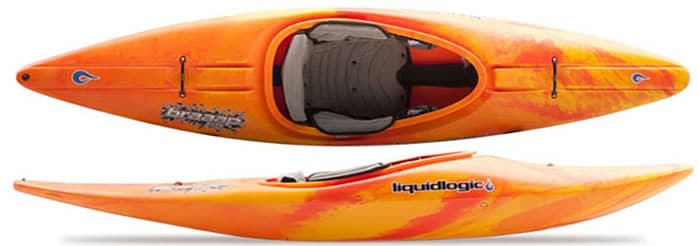
At only 46lbs this kayak is easy to handle in and out of the water.
This boat is excellent for both the novice and for more experienced whitewater kayakers.
The LiquidLogic Delta V 88 – the best whitewater kayak for beginners who like speed
This is a creek boat that will behave well in just about any situation.
Slightly heavier than the 69 model mentioned above, weighing in at 49lbs, the boat handles well in turbulent and calm waters.
With solid edges, the smooth Braaap inspired rocker and a shorter platform, the Delta V gives the novice paddler enough control to feel safe while allowing the more experienced whitewater kayakers room to explore their limits.
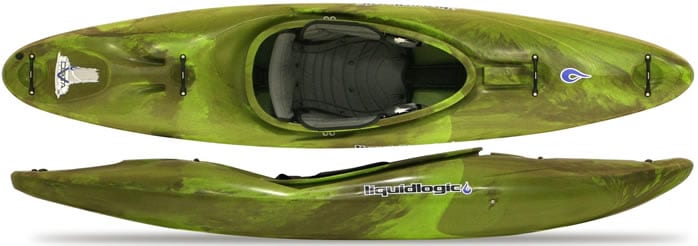
The Delta V features a unique stern called the “Turbo Booster” which helps to accelerate the kayak forward when engaged after a drop.
The nimble and intuitive feel will often make difficult maneuvers seem easy.
3. Surf Kayaks Let You Ride The Waves
Surfing is not for the faint of heart! But for those with an adventurous spirit, and a call to the waves, a surf kayak is one of the best ways to experience the crest of a wave.
By blending, and enhancing, the ergonomic shape of a whitewater kayak with the outstanding capabilities of a surfboard, manufacturers have given us the totally unique surf kayak.
More stable than a surfboard and a little more neat and dangerous than a whitewater kayak these boats allow you to access large waves, strong currents and high winds all day long.
These surfing powerhouses are made for very specific extreme sport purposes and are almost impossible to sink.
Even when flipped a surf kayak’s design makes it easy to flip it upright again by an experienced kayaker.
Surf kayaks are designed to be used like a surf board
Like a whitewater kayak, a surf kayak has a rather unique design that sets it apart from other types of kayaks.
However, whitewater kayaks (often referred to as river kayaks) are so adept at handling turbulent water that they are often used for surf kayaking though they do have a different design.
A surf kayak has many design similarities to a surfboard but is designed for paddling.
Some boats are even fitted with fins to help them better ride the waves.
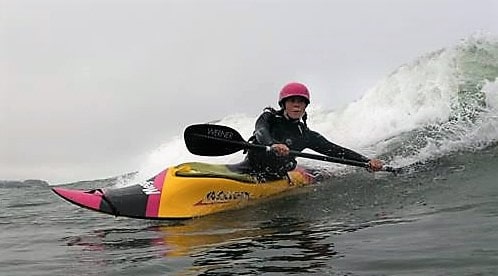
A surf kayak is very distinctive and has its own particular look that sets it apart from other kayaks.
A surf kayak has an upturned nose at the bow and a sleek downward facing stern.
These kayaks tend to be short in length for better control when riding waves.
Surf kayaks are available in long and short hull designs as shown in the video below (where you are also shown how you can use a whitewater river kayak for kayak surfing).
Pros of surf kayaks
- These kayaks have distinctive design characteristics, similar to a surfboard, for riding waves.
- Surf kayaks keep the paddler always embraced tightly in the cockpit.
- Great maneuverability in turbulent water.
- Offer excellent speed even when carving turns.
- Power seat can be adjusted for a wide array of motions.
- Different hull designs available.
Cons of surf kayaks
- Requires experience and skill.
- Not for a beginner.
How to choose the right surf kayak (video)
Top choices – the 2 best surf kayaks
Below are some good surf kayaks to help you see what is available on the marketplace.
The Boogie 50 offers fast surfing
This is a small 7ft 9″ kayak that is a very affordable way to hit the surf.
Its designed with a long front end that offers speed and high performance.
A great fit for paddlers of all sizes this fast surfing kayak gives the paddler a lot of carving power.
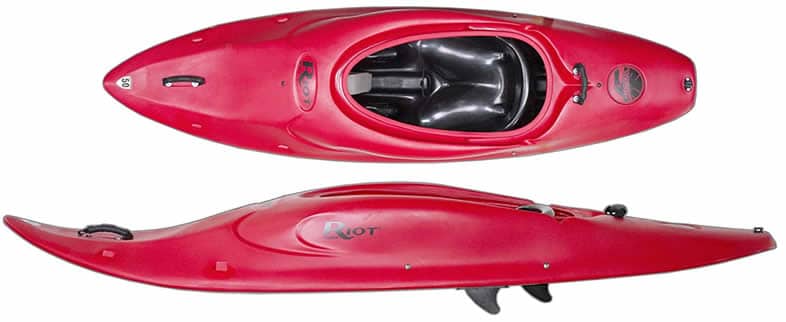
It has a squash-tail template with super-sharp rails.
The Boogie 50 comes with the usual surfing power seat, customizable foam foot-blocks, drain-plug, molded padded knee pockets and grab handles.
At only 35lbs this kayak is super easy to transport and store.
Mega Kayaks make some of the very best surf kayaks in existence
For those who prefer the longer surf kayak (which actually give you more control than the smaller ones) I give you the Mega Vamp.
Mega Kayaks are American designed British kayaks (go figure) that have only recently become available in the US.
Designed to handle the seriously turbulent, and big, waves that hit Britain these watercraft are the crem-dela-crem of surfing kayaks, with a price tag to match.
The Mega Vamp surf kayak comes in at 9″ x 23.6″ with a 5″ tail rocker.
This boat is quick and reactive with a “v” tail for faster, more controlled carving.
It has softened rails and a rounded tail profile that allows it to work with or without fins allowing you to use it in whitewater (with fins removed).
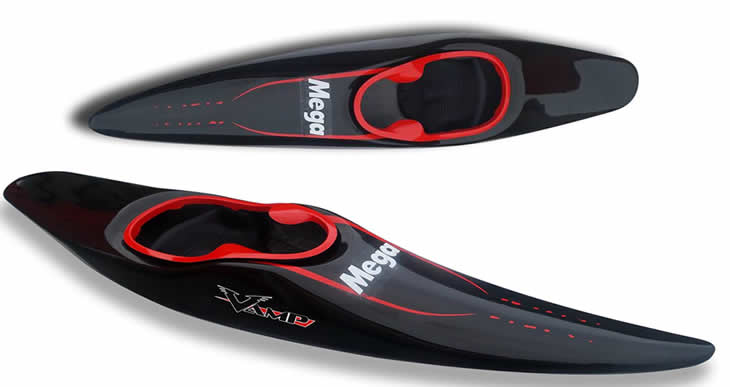
This surf kayak is seriously fast!
There are of course other Mega kayak models available and each one is worth every penny.
Mega kayaks are now available from the USA dealer Savannah Canoe and Kayak.
4. Sea/Touring Kayaks
As you have already seen different kayak designs are better suited to some applications than others.
So it should comes as no surprise to learn that not all kayaks are seaworthy.
To get into the ocean you need a sea kayak.
Sea kayaks are also known as touring kayaks because they can be used over long distances in open water.
Exploring the ocean in calm waters or on the roller coaster of currents and waves is what sea kayaking is all about.
This kind exploration requires a more robust type of kayak that offers not just superior stability, and improved paddling efficiency, but that also has sufficient storage space for your gear.
A touring kayak is specially designed for long distance use and stability in the ocean
These sit in kayaks offer ample storage space, adjustable sliding foot braces, and a unique custom-fit back resting option. This makes day and overnight cruising equally convenient for the paddler.
A sea kayak is much longer than other types of kayaks. Most sea kayaks measure from 12ft to 24ft in length.
The larger vessels are usually designed to carry two people though there are many modern kayaks that are capable of carrying three people.
These kayaks tend to be made from very robust materials such as fiberglass, rotomolded polyethylene, thermoformed plastic, blow molded polyethylene or carbon-kevlar.
Sea kayaks incorporate the design of several different kayaks into one.
A sea kayak offers the paddler higher cruising speed, ease of straight-line paddling, and comfort for long journeys while also incorporating much-needed space for cargo.
Unfortunately, these advantages come at the expense of maneuverability – usually not a problem as you have plenty of space to turn in the ocean and in large bodies of water.
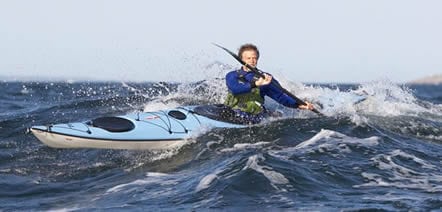
Although most touring kayaks will be store-bought you will see some handmade kayaks on the ocean.
DIY made kayaks, like homemade Jon boats, are made from wood.
However, unlike a homemade Jon boat a homemade kayak will be usually have the wood covered with a layer of fiberglass.
Be sure to read our guide to kayaking in the ocean if this is the type of kayaking activity that interests you.
These boats are also excellent for boat camping.
Pros of a touring kayak
- These kayaks have a longer, sleeker form and offer more ease of paddling.
- They are very comfortable even over long journeys.
- The narrow sitting position of this kayak lets you stay fairly dry and offers a more efficient paddling against the current.
- Their large cockpits are roomy but compact.
- Waterproof cargo compartments are made easily accessible by deck hatches.
- These boats track straight.
- They give a good deal of control on turbulent water while feeling stable on calm water.
Cons of a touring kayak
- One needs to have a thorough know-how for how the boat handles before venturing past the shoreline.
- Experience is needed to tackle wind and waves.
- They are large watercraft that are not as easy to store.
- They are best used in open waters and may be too long for rivers and streams with very tight turns.
Top choices – the 4 best sea kayaks
Below I have included a fiberglass touring kayak, Polyethylene sea kayak and one of the world’s first inflatable sea kayaks.
All of the boats perform the same functions and are ideal for long camping tours or simple day trips on the ocean.
The Chatham 18 fiberglass sea kayak
The Chatham is an 18ft long 20″ wide fiberglass sea kayak capable of offering great stability even in very choppy waters.
The boat tracks well and keeps you fairly dry in choppy conditions.
The ride is comfortable though you need to be aware of your center of gravity as it can feel a little tippy (like many sea kayaks).

If there is a downside it’s that the storage could be bigger to allow for more gear on longer expeditions.
Weighing in at just 50lbs this kayak is lightweight and easy to transport.
All-in-all this is a really nice sea kayak.
Riot Kayaks Edge polyethylene sea kayak
The Edge is a 14.5ft Polyethylene day touring kayak.
Although the boat is more than capable of making long voyages you may not have enough storage space for the journey.
With its slender bow and slim deck profile, this rudder-equipped sea kayak has just the right amount of chine and keel to make it track well while offering a fair amount of speed.

The Edge features a custom-fit seating system, adjustable sliding foot braces, both bulkhead-sealed front and rear compartments with dual-density hatch cover.
With reflective lifelines, drain-plug, integrated thigh braces, pilot rudder system, fore and aft shock cord storage with paddle hook and safety straps, and a security bar you get a solid boat for the money.
The kayak measures 14.5 feet by 22.5″ by 12″ and weighs in at 60 lbs.
And, it’s super cheap!
NOMAD inflatable sea kayak
The Nomad is a 14 f 5.2″ long 31.5″ inflatable kayak that weighs only 38 lbs.
Although it is inflatable it is a more-than-capable sea kayak.
This boat can handle longer double paddling excursions out in open water or short day trips along the shoreline.
It features a fairly large storage area for carrying gear.
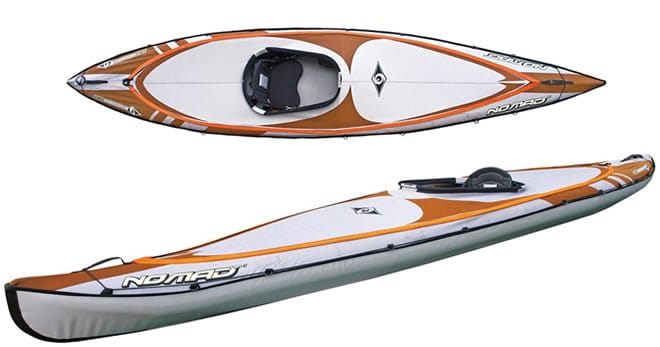
It has a high pressure inflatable keel and bottom that together create a dynamic and high performance seafaring hull shape but at a fraction of the weight of its contemporaries.
With an excellent paddle position and a higher bow section, extended length, and a flexible decking system for better internal protection, this kayak really delivers on performance.
The Nomad is a solo kayak that comes with higher bow section, flexible decking (it can be removed) giving you a high level of paddle-comfort and protection for those extended solo trips.
The Nomad comes complete with pump, backrests, footrests and travel/storage bag.
The Hudson wooden sea kayak
Prefer wood? No problem!
Wood kayaks are hard to come by, especially ones that are seaworthy.
If you prefer wood then be sure to check out the stunning 18 foot Hudson made from cedar and covered with fiberglass.
It’s pricey but its worth every single penny!
The Hudson 18 is a stunning kayak that is not just admired for its beauty but is also a favorite because of its versatility.
This is a great kayak for paddlers of all skill levels having been used for everything from fishing to touring in open water, surfing, and even racing.
The low back deck offers maximum comfort and permits the paddler to lean back with ease and the fore-deck is high enough for most paddlers to get their legs in and out while seated.
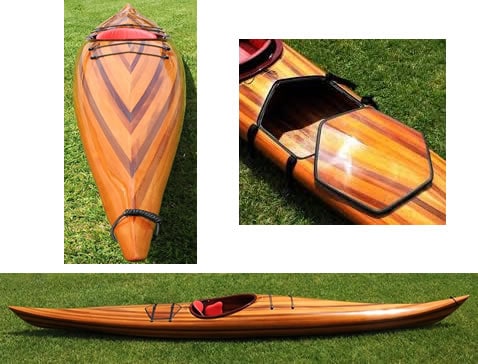
This kayak is fast and efficient and surfs very easily while also being perfect for use on lakes, rivers, and even in open water.
This wood boat is completely handcrafted over a 500 hour period in the USA using traditional boat building methods.
Strips of cedar are joined together by hand and then encapsulated in fiberglass which is bonded in place with epoxy resin.
Then the boat is coated with a marine varnish.
The combination of fiberglass and epoxy resin makes the boat very strong but completely transparent.
This means you get the hard shell of a fiberglass finish but the striking beauty of wooden boat.
This stunning kayak is 18 foot long and weighs only 50lbs. With a weight capacity of 550lbs and ample storage space this is a beautiful but fully functional touring kayak.
5. Fishing Sit In Kayaks
Although the most popular fishing kayaks tend to be sit on top models, (see our to choosing the best sit on-top kayak) there are quite a few sit in fishing kayaks available.
A fishing kayak has been designed for calm water angling
A sit in fishing kayak is for paddlers who want the traditional design, feel and performance of a sit in kayak but who also want to be able to fish.
A sit in kayak offers better paddling over greater distances, than a sit on-top kayak, allowing a paddler to easily move spots when needed and also offers more stability in challenging waters.
If you want to know the difference between a sit in and sit on-top kayak read this article.
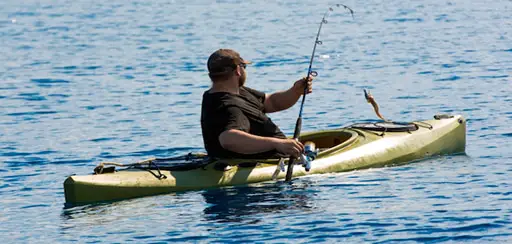
The cockpit of most sit in fishing kayaks is usually smaller than a recreational kayak and looks, and feels, more like a traditional sea kayak only larger.
However, the cockpit still maintains good enough width for comfort and onboard maneuverability, like a recreational kayak.
These boats combine good secondary stability so you can fish in fairly choppy waters but still offer enough primary stability so you remain stable while you fish.
They will also have plenty of storage for gear and fish.
Pros of a fishing kayak
- Fishing sit in kayaks have are designed for distance paddling.
- Good secondary stability for fishing in choppy waters.
- Good primary stability for fishing.
- More stability than a sit on top kayak in choppy waters.
- Good storage for gear and fish.
- Beginner friendly.
Cons of a fishing kayak
- Slower than other kayak types.
- Not as maneuverable as other kayaks.
- Not as much room to move or store gear/fish as on a sit on top kayak.
Modifying a standard recreational kayak for fishing is possible
Some paddlers will modify their existing kayak for fishing and this is fairly easy to do as you can see from the video below.
If you do go down this route be aware that you will have much less space for storage than you would if you bought a fishing kayak unless you convert a large sea kayak.
The conversion in the video was completed on this type of Pelican kayak.
Top choices
We have two choices of sit in fishing kayak for you. One is made from plywood with a fiberglass finish and the other is 12 ft polyethylene hard shell.
12 ft Polyethylene sit in fishing kayak
Made from sturdy Polyethylene this sit in kayak comes with a portable accessory carrier and is set-up for fishing.
This 12 footer is great for lakes, rivers and streams. It tracks really well and lets you paddle with ease while simultaneously offering maximum stability.
It’s lightweight weighing in at only 47lbs so it’s very easy to transport and store.
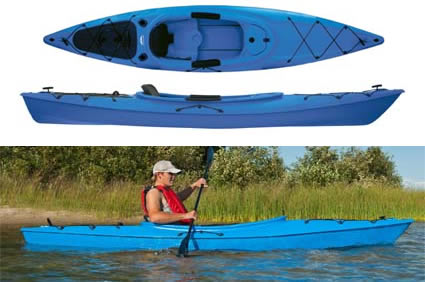
This kayak has a 375lb weight capacity.
It comes with flush mount fishing rod holders and an onboard storage compartment. Along with the additional portable accessory carrier (P.A.C. ), can be used as a tow-behind, this means you have a lot of storage available for gear and your catch.
This fishing kayak is made from hard shell UV-stabilized Fortiflex® high density polyethylene so it can take some really hard knocks.
It has adjustable foot braces, a large comfortable seating area with thigh pads, shock cord deck rigging and a covered storage compartment.
With retractable carrying handles it is easy to load and unload for transportation.
It’s also very cheap!
Mill Creek Hybrid
With the looks of a sea kayak and the finish of a high-class yacht this 16 ft 6″ kayak is nothing short of stunning!
But it isn’t just its looks and feel that make it special.
The Mill Creek Hybrid offers high-performance with a high level of comfort.
It is easy to maneuver and paddle, rewarding you with both speed and superior stability.
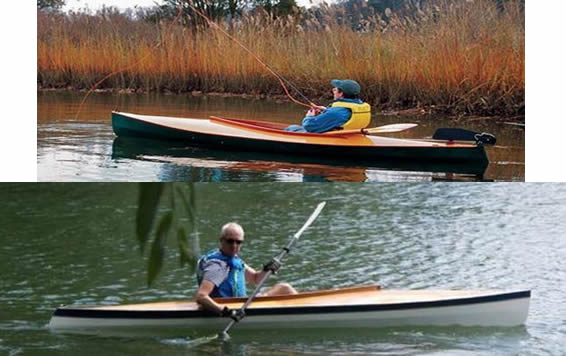
The Mill Creek was originally designed to be an alternative to the more traditional sea kayaks.
However, it quickly gained in popularity among all kinds of paddlers, including anglers, due to its lightweight nature and versatility. So, now it is used for a variety of kayaking activities.
The only problem with this gorgeous boat is that you have to build it yourself from the kit provided.
The kit includes plans that any DIYer will have no problem following. It has all pre-cut parts, bulkheads, Keepers™ (adjustable foot braces), epoxy kit, fiberglass for the hull and deck, slat-style seats, and rub rails.
The additional Mill Creek hatch kit includes 2 hatch covers and frames, gaskets, straps, buckles, and fasteners.
When the boat is finished it will take your breath away.
Sit in fishing kayak set up (video)
6. Racing Kayaks Are Used For Amateur And Professional Racing
If you have a strong interest in aqua sports, then a racing kayak may be a better fit for you.
Racing kayaks are designed for speed. They are longer than most other kayaks and require a certain degree of skill to paddle as they will feel very tippy to a beginner.
Racing kayaks are designed for maximum speed on the water
When choosing a racing kayak it is important that you understand your own abilities.
Many people new to the sport want the fastest kayak they can get their hands on without realizing that gaining increased speed comes at the cost of stability.
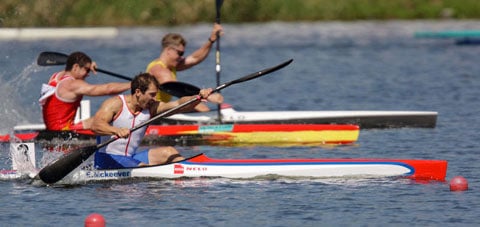
You can’t race if you end up head first in the water.
Racing kayaks take skill to master especially at speed.
Pros of a racing kayak
- Most suitable for flat water sprint and marathons.
- These boats are super fast.
- Racing kayaks are incredibly fun to paddle at speed.
Cons of a racing kayak
- Not the best choice for other kayaking activities.
- Not for beginners.
- They are expensive.
Top choice – the best racing kayaks
Below is our top pick for a great racing kayak.
We have chosen a Nelo because the manufacturer has a proven record for building very fast boats. With several Olympic medals under their belt it’s easy to see why they are the choice of champions.
The Nelo 520 XL
The Nelo 520 XL is a 17 ft speed machine designed with downwind surfing ability in mind while still providing good flat water speed.
It’s offers exceptional maneuverability and incredible flat water speed while remaining very stable.

The comfortable seat bucket, with low profile cockpit, allows for optimal technique and an ability to use leg drive, thus ensuring maximum power to your paddle stroke.
The Nelo 520 XL comes in two different models. One is constructed from Carbon Kevlar Vacuum Epoxy and the other from Carbon Epoxy Vacuum Construction.
What’s the difference?
I have no idea! I guess you need to be a professional kayak racer to be able to tell the difference, for us mere mortals they seem pretty much the same.
The take-away – how to find the best sit in kayak for you
What is the best sit in kayak?
The best sit in kayak is the one that is designed for your specific needs.
Not all kayaks are the same.
You must get a kayak that has been designed for the environment you will use it in and for the activities that you want to use it for.
For example, getting a whitewater kayak for recreational use on a calm lake will spoil your fun as the boat will feel tippy.
For calm recreational use get a flat bottomed recreational kayak.
On the flip side, using a recreational kayak for whitewater kayaking will see you tipped over and wet.
Once you know which type of kayak you need, and before you make a purchase, be sure to check the customer rating of the boat you are interested in.
And, also read some reviews by confirmed buyers (not online reviews written by affiliates).
This is why I love Amazon because you can see what people who actually own a product think about it. But, of course, there are other suppliers who also include reviews from past buyers so shop around.
Also, don’t forget to get all your kayaking essentials sorted out before you hit the water, including a PFD.
Finally, enjoy yourself. Kayaking is tremendous fun and with the right kayak and the right gear you will be hooked from your first time on the water.

